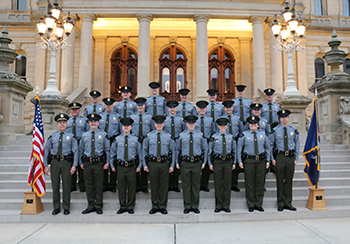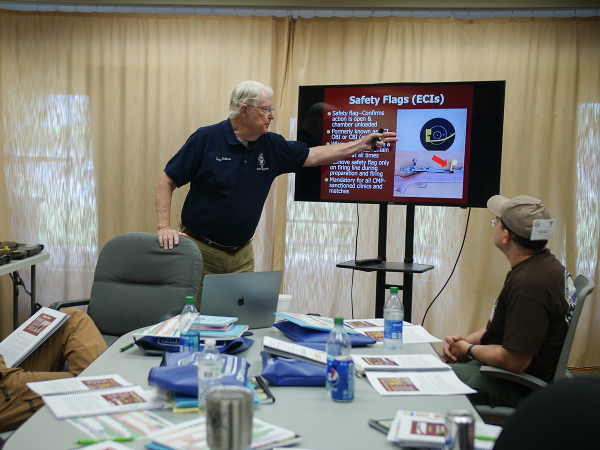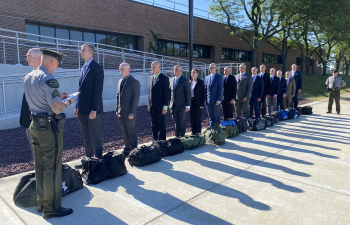Outdoor survival training prepares MI DNR recruits for lifesaving work

Week 14: Oct. 15-21, 2017Like tiny meteorites, the glowing, yellow sparks hurtled toward the ground as the conservation officer recruit flicked his wrist. Scraping the metal bar against the magnesium rod on the fire starter tool worked just as his instructor had demonstrated earlier.
The shower of sparks instantly ignited the Vaseline-saturated cotton ball he had prepared, and after strategically arranging pieces of kindling on top, the rising flame brought a satisfied smile to his face.
The recruit had just learned one of the most basic but essential outdoor survival skills – the ability to make fire.
It was one of many techniques he and his classmates acquired during Week 14 of the Michigan Department of Natural Resources Conservation Officer Recruit School, which covered outdoor survival training and search and rescue procedures as discussed in this brief video.
Stayin’ alive
Week 14 brought recruits back to the Camp Grayling Joint Maneuver Training Center, where they had their initial firearms training during Week 9. On this trip, the class spent quality time with experts from Emergency Response International, who taught recruits about wilderness safety and survival, as well as the fundamentals of a search and rescue (SAR) event. ERI has partnered with DNR’s Law Enforcement Division for several years to train conservation officers, but this was the first time the company provided instruction at the recruit school.
The class spent Sunday afternoon and evening getting a primer on SAR events, including lost person behavior, SAR scene management, survival priorities and mindset, legal aspects, and GPS/compass mapping techniques.
Learning to prioritize
Most of Monday was spent in the field. Recruits learned compass skills and mapping techniques, as well as knot-tying for creating shelters and improvised rescue tools. They also were taught to prioritize what they need to do if faced with an outdoor survival situation. In addition, instructors showed them what they can use to create shelter, fire and food, using only tools they either carry on themselves or will carry in their patrol bags. In one exercise, trainees had to create a “quick action shelter” and build a fire in a short amount of time, with instructors evaluating their results.
In one exercise, trainees had to create a “quick action shelter” and build a fire in a short amount of time, with instructors evaluating their results.
Tuesday morning saw recruits back in the field to continue their SAR training. The emphasis was on using basic techniques to search an area. In one scenario, a mannequin dressed as a lost hunter was placed in the woods. Recruits were expected to locate the hunter and find ways to bring him back to safety.
Flying high
Tuesday afternoon had recruits flying high as the training was some of the most exhilarating they had experienced to this point. A U.S. Coast Guard MH-60 Jayhawk helicopter from Coast Guard Air Station Traverse City, and a Michigan State Police Bell 206L3 helicopter from Saginaw, flew to Camp Grayling to assist recruits in a “vectoring” exercise.
Recruits took turns calling the choppers to their locations as they would in an actual field incident. They learned how to communicate with the pilots over the radio and which codes to use for various situations. After meeting both air crews and touring the helicopters, recruits learned how to assist the Coast Guard in rescuing individuals on the ground and hoisting them to safety in a hovering chopper.
Teams of recruits took turns either riding in the helicopter as it hovered above their colleagues, or remaining on the ground to retrieve the safety basket and then guide it back up to the rescuers above.
“This is very valuable training not only for our crew on board the helicopter, but for these future conservation officers,” said Chief Petty Officer Will Matthews, a member of the Coast Guard air crew. “We work hand in hand with many agencies around the state when it comes to training and today is no exception. We’re glad we could help.”
Ending with a bang
On Wednesday and Thursday, the class logged several hours on the firearms range. Recruits continued to become proficient with their duty side arms, the Sig Sauer P229 RDAK. In addition to basic marksmanship, they applied their skills to new tactics such as shooting from behind barricades, and shooting while moving. Because their work week began Sunday, recruits were dismissed from Camp Grayling Thursday afternoon, giving them an extra day of rest before reporting back to the academy to tackle Week 15.
Turning point
Week 14 was unique in that the class did not have structured physical training. Instructors let recruits come up with their own exercises. While that may not sound like a big deal, it’s a turning point in recruits’ life at the academy. As the school progresses, recruits will be expected to start making decisions for themselves and as a class.
The academy’s controlled environment certainly will continue to guide daily operations. But now, staff will evaluate trainees as they evolve from “recruits” to “probationary conservation officers.” Their transformation remains a work in progress, for sure. But each day they complete and every challenge they overcome brings them closer to the coveted title of Michigan conservation officer.
Subscribe to the weekly conservation officer academy blog, which also will be posted on the Michigan DNR Facebook page. View previous blogs from Recruit School #8.







